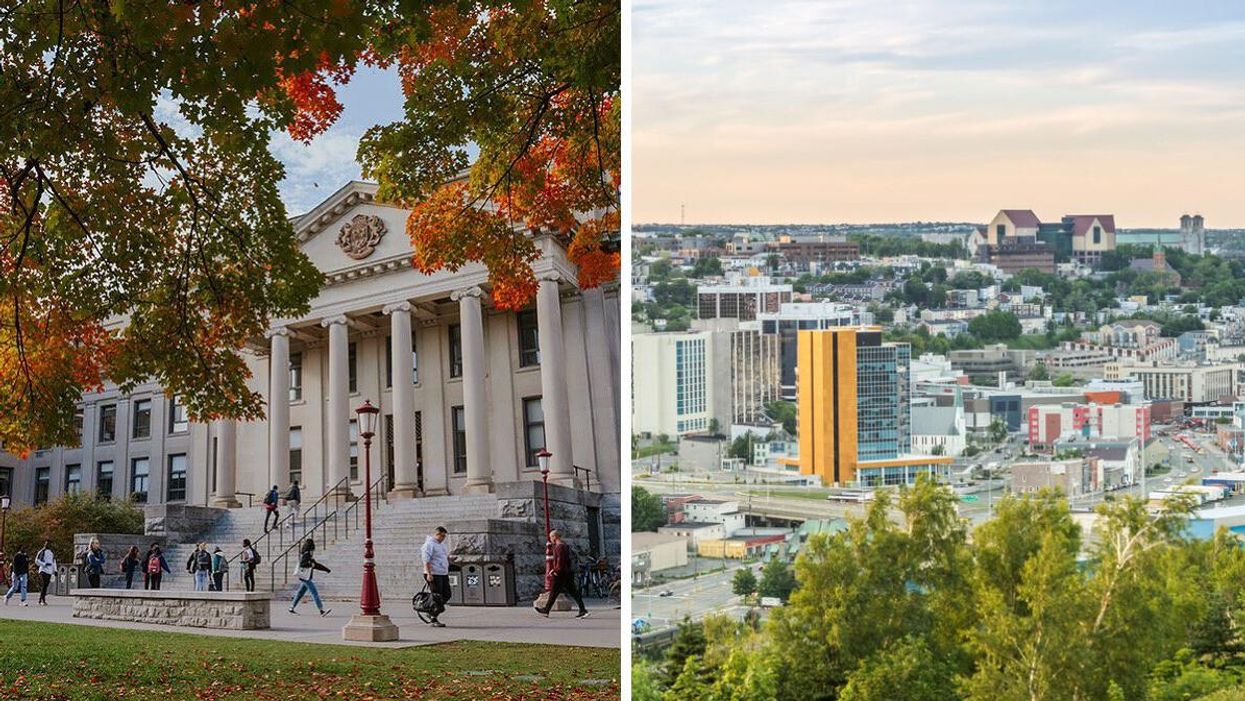These Are The Least Educated Provinces & Territories In Canada
Data on the most educated places in the country was also shared.

University of Ottawa campus. Right: Skyline of downtown St. John's, Newfoundland.
When it comes to secondary and post-secondary education in this country, new figures are revealing what could be considered the least formally educated provinces and territories in Canada.
On October 18, 2022, Statistics Canada released data about the educational attainment of Canada's population, which refers to the amount of schooling people in this country have.
These stats show what level of education people in this country from the ages of 25 to 64 had each year from 2017 to 2021.
As of 2021, the places with the highest proportion of people who, as the highest level of education achieved, have a high school education, education below high school graduation or no education, are Nunavut at 39%, the Northwest Territories at 15%, Newfoundland and Labrador at 11% and Quebec at 10%.
Those provinces and territories are followed by Nova Scotia, New Brunswick, Manitoba and Yukon at 8%.
P.E.I. and Saskatchewan are both at 7% while Alberta and Ontario are at 6%. B.C. has the lowest proportion of people who only have a high school education or less at 5%.
When it comes to the most educated provinces and territories, Statistics Canada released data on the attainment of tertiary education, which refers to all post-secondary institutions including universities, colleges, technical training institutes and others.
As of 2021, the proportion of people with post-secondary education is highest in Ontario at 68%, B.C. at 62% and P.E.I and Nova Scotia at 61%.
Then, both New Brunswick and Yukon are at 59%, Alberta is at 58% and Quebec and Manitoba are at 57%.
In Newfoundland and Labrador, that figure is 54% while it's 50% in Saskatchewan, 49% in the Northwest Territories and 38% in Nunavut.
It's important to note that figures in many parts of the country could be disproportionate given the history of residential schools in Canada and the impacts of the forced assimilation, physical, psychological, sexual and emotional abuse and neglect that happened at those schools.
Entire generations of Indigenous children were kept away from their families, communities and cultures, through a system that existed between the 17th century to the late 1990s.
According to the federal government, "the intergenerational effects of the trauma include lower levels of educational and social attainment."
To this day, the lasting effects of the residential school system can be felt throughout many Indigenous communities all over the country.
What are the best universities in Canada?
According to the QS World University Rankings for 2023, McGill University holds the spot as the best Canadian university in the world.
That post-secondary school is followed by the University of Toronto and the University of B.C.
Another ranking of the top universities in the world by Times Higher Education named those three post-secondary schools as the best Canadian institutions of their kind but in a different order.
The highest-ranking school in Canada is the University of Toronto followed by the University of B.C. and McGill University.
Also, the best universities in Canada based on reputation were revealed and they are the University of Toronto, the University of Waterloo, the University of B.C., McGill University and McMaster University.
What are the least educated states in the US?
A recent study by WalletHub listed the least educated states in the U.S. and they're all in the south.
The least educated states based on the quality of schools, graduation rates, educational attainment and more are West Virginia, Mississippi, Louisiana, Arkansas, Alabama and Kentucky.
The Indian Residential School Survivors Society Emergency Crisis Line is available across Canada 24/7. Those who may need support can call 1-866-925-4419.
